September 4, 2023 dialog
This article has been reviewed according to Science X's editorial process and policies. Editors have highlighted the following attributes while ensuring the content's credibility:
fact-checked
peer-reviewed publication
trusted source
written by researcher(s)
proofread
AI algorithm learns microscopic details of nematicity in moiré systems

Identifying and understanding experimental signatures of phases of matter is usually a challenging task due to strong electron interactions in a material and can become even harder due to external influences in samples with the presence of impurities or other sources of deformations. Typically, these interactions between the electrons in a material give rise to fascinating phenomena such as magnetism, superconductivity and electronic nematicity.
As an example, the interplay between nematicity and strain (a form of sample deformation) is a pertinent topic, since, from a fundamental perspective, both break the rotational symmetry of the system—in the first case, this is due to interactions between the electrons; in the latter, it is a result of a shift in the positions of the atoms.
In both cases, however, this is seen in experiments as a preference for electrons to occupy states through the material in a way that favors a certain direction. As such, confirming if observed anisotropies are due to strain or if they are indeed a result of interactions is a very challenging task.
In addition, as the amount and complexity of data obtained in experimental setups increases, a more effective way of processing this information becomes imperative. A natural question, which has been explored in the past few years in many contexts, is whether data-driven approaches, mainly within artificial intelligence (AI), can contribute to this task and hopefully even hint into previously undiscovered physical properties of materials.
In this scenario, a potential use of AI could be further understanding the relation of strain and nematicity in materials. If you look at certain images and see a clear sign of rotational symmetry breaking, can a machine learning algorithm do the same? Can it understand and connect to fundamental microscopic theories of nematicity and distinguish them from the sample deformations? Moreover, can it extract more information from the data than the trained eye of a physicist? In a recent work published in Nature Communications, we demonstrate that the answer to all of these questions is yes.
How electrons organize themselves in moiré systems
Nematicity has been recently observed in moiré systems, namely in twisted bilayer (TBG) and twisted double bilayer (TDBG) graphene (Fig. 1). These systems are typically composed of stacks of graphene layers with a relative twist between them. They have attracted immense attention from the condensed matter community in the past few years due to their high tunability and the increasing spatial resolution available in experimental setups. These characteristics make these systems a perfect playground for testing theories from strongly correlated phenomena.
To understand this tunability better, we consider how these phases are accessed experimentally in scanning tunneling microscopy (STM). Typically, a potential bias is activated between the material and a conducting tip from the STM such that charge carriers can jump between the two via quantum tunneling. The flow of these electrons can be tracked as a function of the potential bias, giving access to the local density of states (LDOS). This object gives us information about the states that the electrons are more likely to stay in a certain material.
If we change the potential bias, the electrons will reorganize themselves in a certain way corresponding to a "filling" of the states. For each filling, a certain phase of matter can be favored. The pattern of nematicity, for example, can be seen in these experiments with the appearance of unique stripes over the LDOS images for a specific filling in TDBG (Fig. 2). If you rotate the LDOS maps with nematicity in Fig. 2 by 120º, the orange stripes will not go back to the same direction, a feature that is always present in TDBG (first LDOS map in Fig. 2) when nematicity is not present.

Nematic phases are also quite intriguing from a theoretical perspective because they can be linked to the favoring of certain types of superconductivity in materials as they come in many types, each depending on certain microscopic details: electrons can reorganize themselves in orbitals due to fluctuations of spin, charge, or even due to the influence of lattice vibrations in the material.
In addition, in moiré systems, the twist angle can favor the electrons to occupy states through the moiré patterns (green regions in Fig. 1) in a way that breaks the rotational symmetry distinctly than when the same occurs in the graphene scale (small bonds in the zoomed region of Fig. 2). These two cases in TDBG are referred to as moiré and graphene nematicity.
Learning nematicity
Given experimental data of nematic phases, one can typically define its microscopic theory in a material, but directly obtaining these details from the experimental data is often an ill-defined inverse problem. To circumvent this issue, we trained a convolutional neural network (CNN) algorithm to recognize features of nematicity from the data.
We showed many images from LDOS with different types of nematicity with and without strain and asked the algorithm what type of physical features they had based on labels that were connected to the particular theoretical models (Fig. 3). Additionally, we also queried the algorithm about the values of strain in the samples. Once we certified that it could perform well on theoretical data during a training stage, we presented the previously unseen experimental data with nematicity.

The CNN found a preference for moiré over graphene nematicity in the region of filling where nematicity was found experimentally to be stronger. Additionally, and more surprisingly, strain did not change much as the filling was increased, and got smaller in the region of strong nematicity. This indicates that the rotational symmetry occurs mainly due to the strong interaction between the electrons (Fig. 4). The CNN predictions were robust even in the presence of spatial defects in the LDOS maps.

We are confident that ML techniques have enormous potential for analyzing experimental data in moiré systems and beyond, revealing insights that are difficult to extract by conventional means.
This story is part of Science X Dialog, where researchers can report findings from their published research articles. Visit this page for information about ScienceX Dialog and how to participate.
More information: João Augusto Sobral et al, Machine learning the microscopic form of nematic order in twisted double-bilayer graphene, Nature Communications (2023). DOI: 10.1038/s41467-023-40684-1
Journal information: Nature Communications
João A. Sobral is a PhD student from the Institute for Theoretical Physics III at the University of Stuttgart working under the supervision of Prof. Mathias S. Scheurer on the intersection of many-body physics and artificial intelligence.





















